Learn about colonial Schenectady and its stockade
To the Editor:
“The Place Beyond the Pines,” which is the translation of the Iroquois word, “Schenectady,” was founded by the Dutch in 1661. Located west of the Pine Bush, colonial Schenectady became a melting pot of diverse peoples and cultures.
Its placement near the confluence of the Hudson and Mohawk rivers was the ideal location for traders looking to link the fur trade to European markets as well as to those to the north and east.
Understanding that the success of their businesses depended on the skills of people from a variety of backgrounds, Dutch entrepreneurs were comparatively tolerant of people of other cultures and religions. Besides the Dutch, many early settlers were French, Scots, and Scandinavians, as well as Blacks and Mohawk Indians.
The desire to control the fur trade in this area led to many wars and to the necessity to protect the area from invaders. Realizing this, in about 1664, the residents of colonial Schenectady built a stockade around the settlement.
However, this fortification could not keep them free from the effects of marauders and conflicts, and the history of this area is filled with many dramatic ups and downs that demonstrate the resilience and entrepreneurship that lives in the heart of Schenectady.
The Stockade area of Schenectady comprises over 40 houses that are more than 200 years old and is the first Historical District established in New York.
Michael Diana, historian and director of education at the Schenectady Historic Society, will present this enlightening program on Tuesday, April 2, at 7:30 at the Voorheesville Public Library’s Community Room located at 51 School Rd. inVoorheesville. The program, co-sponsored by the New Scotland Historical Association and the library, is free and open to the public.
Judy Kimes
Publicist
New Scotland
Historical Association
